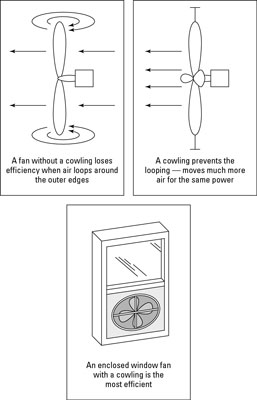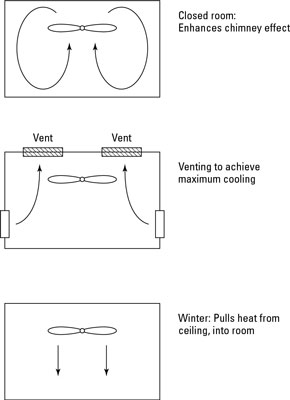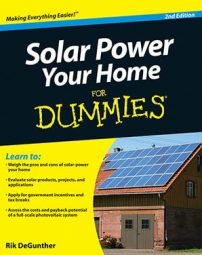Using fans to cool your home is energy efficient. After you determine the natural ventilation scheme in your home, you can enhance the effect with the use of active fans. When choosing fans, check for efficiency ratings.
Fans are rated by how much air they can move in a given amount of time. The most common spec is cubic feet per minute (cfm). Calculate how many cubic feet are in your house, room, or attic (length x width x height) to find the proper-size fan.
Fans move air most efficiently when they have a cowling. Cowlings prevent air around the tip of the blades from circling about outside the blades, instead forcing that air forward, yielding much more air for the same power draw.

Many fans are available at a wide range of prices. Choosing the right unit for your needs can ensure you get the effect you're looking for.
Oscillating fans: These fans move back and forth and work only for convective cooling, and they're dubious at that.
Box fans: Box fans are portable units you can move around as the need occurs. Most have some kind of cowling. Blade design helps determine the efficiency of the air flow.
Window fans: Window fans come with a sheet metal mounting that fits right into an open window and seals around the edges. Most of these fans are very efficient. The best way to move air in your house is by using a good window fan mounted into the most appropriate window, probably upstairs on the downwind side of your house (the fan aims out the window). One small window fan mounted properly can do the same work as a number of large fans scattered about the house.
Exhaust fans: Exhaust fans shouldn't be used when the HVAC system is running, but if you need to, open a small window nearby so that you can control the air movement.
If you're cooking in the summer when the AC is on, exhaust fans can make a big impact on the comfort in your house. This is true especially if you're boiling liquid, because not only does that heat the air, but it also humidifies. Run the fan on high, but crack a nearby window so that you don't pull expensive, cooled air out of your house.
Ceiling fans: Here's how to use your ceiling fan to get the most benefit:
Create convective cooling: With a ceiling fan, you can get convective cooling by running the fan in either direction.
 Ceiling fans work best when the fan blades are 7 to 9 feet above the floor and 10 to 12 inches below the ceiling.
Ceiling fans work best when the fan blades are 7 to 9 feet above the floor and 10 to 12 inches below the ceiling.Draw the heat up: If you have a vent, you can enhance the chimney effect by running a ceiling fan in the reverse direction (aiming the air flow upward, in other words).
Reverse the chimney effect by pushing hot air down: In the winter, you can use a ceiling fan to push hot air back down into the room.
A well-positioned ceiling fan can allow you to lower your thermostat by 4 degrees Fahrenheit and achieve the same comfort level.
Whole house fans: Whole house fans are mounted in the ceiling between a high point in your house and the attic. They draw air through open windows, exhaust it up through the attic space, and cool the attic space
A great advantage is that you can open any window in the house and get air movement in that room.
Attic vent fans: An attic vent fan draws air in from one part of the attic, and out another. There is no air movement in the house below, so attic vent fans can be run when the house is closed up.

